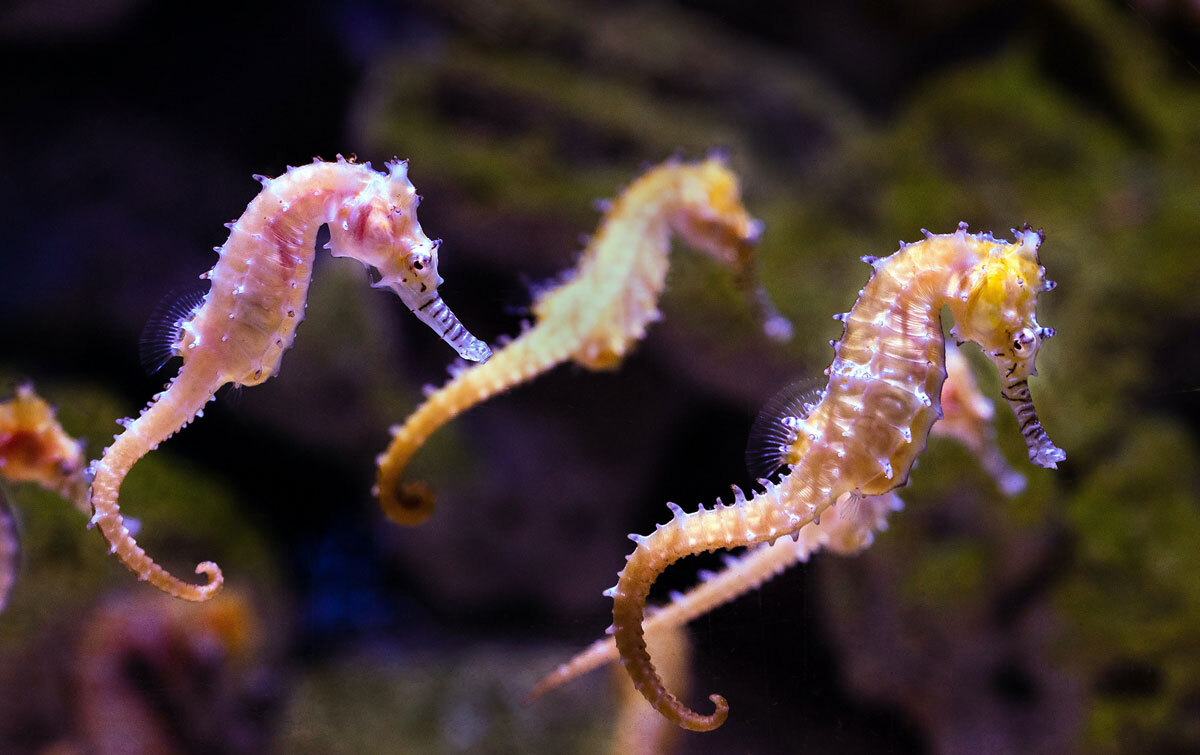
Seahorses are some of the ocean's most intriguing creatures. With their horse-like heads, curled tails, and unique swimming style, they capture our imagination. But what makes seahorses so special? For starters, they belong to the fish family, yet they swim upright. Male seahorses carry the babies, a rare trait in the animal kingdom. They can change color to blend into their surroundings, making them masters of camouflage. Seahorses also have no teeth or stomachs, so they must eat almost constantly to stay alive. These fascinating facts barely scratch the surface of what makes seahorses so extraordinary. Dive in to learn more!
Key Takeaways:
- Seahorses are unique creatures with horse-like heads and prehensile tails. They swim upright, change color, and have fascinating parenting habits, making them a captivating species in the ocean.
- Conservation efforts are crucial to protect seahorses from threats like overfishing and habitat destruction. Public awareness, sustainable fishing, and community involvement play key roles in safeguarding these enchanting creatures.
Seahorses: Unique Creatures of the Ocean
Seahorses are fascinating marine animals that capture the imagination with their unique appearance and behaviors. Let's dive into some incredible facts about these intriguing creatures.
-
Seahorses belong to the genus Hippocampus, which is derived from the Greek words "hippos" (horse) and "kampos" (sea monster).
-
There are about 46 species of seahorses found in shallow tropical and temperate waters around the world.
-
Seahorses have a horse-like head, which is why they are named after horses.
-
They swim upright, unlike most fish that swim horizontally.
-
Seahorses have prehensile tails that can grasp onto seaweed and coral, helping them stay anchored in strong currents.
-
Their eyes can move independently, allowing them to look forward and backward simultaneously.
-
Seahorses lack scales; instead, they have a thin skin stretched over a series of bony plates.
-
They are poor swimmers and rely on their dorsal fin to propel them and pectoral fins to steer.
-
Seahorses can change color to blend in with their surroundings, a form of camouflage.
-
They have no stomachs, so food passes through their digestive systems quickly, requiring them to eat almost constantly.
Reproduction and Parenting
Seahorses have one of the most unique reproductive systems in the animal kingdom. Here are some amazing facts about their breeding and parenting habits.
-
Male seahorses carry the eggs. The female deposits her eggs into a pouch on the male's abdomen, where he fertilizes and incubates them.
-
A male can carry up to 2,000 eggs in his pouch, depending on the species.
-
Pregnancy lasts about 2 to 4 weeks, after which the male gives birth to fully formed miniature seahorses.
-
Baby seahorses are called fry and are independent from birth, receiving no further care from their parents.
-
Seahorses are monogamous and often mate for life, engaging in daily courtship dances to strengthen their bond.
-
Courtship involves synchronized swimming and changing colors to impress each other.
-
The male's pouch provides oxygen and nutrients to the developing embryos, similar to a mammalian placenta.
-
Seahorses can give birth to hundreds of fry at a time, but only a few survive to adulthood due to predation.
Diet and Feeding Habits
Seahorses have specialized feeding habits that set them apart from other marine creatures. Here are some interesting facts about their diet.
-
Seahorses feed on small crustaceans, such as shrimp and plankton.
-
They use their long snouts to suck in food, much like a vacuum cleaner.
-
Seahorses have no teeth, so they swallow their prey whole.
-
They can eat up to 3,000 brine shrimp in a single day.
-
Seahorses rely on stealth and patience to catch their prey, often remaining motionless for long periods.
-
Their eyes help them spot prey from a distance, thanks to their ability to move independently.
-
Seahorses are ambush predators, meaning they wait for prey to come close before striking.
Habitat and Distribution
Seahorses are found in various marine environments around the world. Here are some facts about their habitat and distribution.
-
Seahorses prefer shallow coastal waters, such as seagrass beds, coral reefs, and mangroves.
-
They are found in both tropical and temperate zones, from the Atlantic Ocean to the Indo-Pacific region.
-
Seahorses are often found in estuaries, where freshwater meets the sea, providing a rich feeding ground.
-
They are highly territorial, with males and females maintaining separate territories.
-
Seahorses use their tails to anchor themselves to vegetation, preventing them from being swept away by currents.
-
They are often found in areas with abundant hiding spots, such as seagrass and coral, to avoid predators.
-
Seahorses are sensitive to environmental changes, making them indicators of ecosystem health.
-
Pollution and habitat destruction are major threats to seahorse populations worldwide.
Conservation and Threats
Seahorses face numerous threats in the wild, leading to declining populations. Here are some important facts about their conservation status.
-
Many seahorse species are listed as vulnerable or endangered by the International Union for Conservation of Nature (IUCN).
-
Overfishing and bycatch are significant threats, as seahorses are often caught unintentionally in fishing nets.
-
Seahorses are used in traditional medicine, particularly in Asia, where they are believed to have healing properties.
-
Habitat loss due to coastal development and pollution further threatens their survival.
-
Marine protected areas (MPAs) have been established in some regions to safeguard seahorse habitats.
-
Captive breeding programs aim to reduce the pressure on wild populations by supplying seahorses for the aquarium trade.
-
Public awareness campaigns help educate people about the importance of seahorse conservation.
-
Seahorses are protected under international law, including the Convention on International Trade in Endangered Species (CITES).
-
Sustainable fishing practices can help reduce bycatch and protect seahorse populations.
-
Research and monitoring are essential for understanding seahorse ecology and developing effective conservation strategies.
-
Community involvement in conservation efforts can lead to more successful outcomes for seahorse populations.
-
Seahorses play a crucial role in marine ecosystems, and their conservation is vital for maintaining biodiversity.
The Magic of Seahorses
Seahorses are truly fascinating creatures. From their unique appearance to their unusual reproductive habits, they stand out in the marine world. Males carrying the babies? That's just one of the many surprises these tiny fish hold. Their ability to camouflage and blend into their surroundings helps them avoid predators, making them masters of disguise. Seahorses also have a prehensile tail, allowing them to grasp onto seagrass and corals, which is pretty cool. Despite their small size, they play a big role in the ocean's ecosystem. Sadly, many seahorse species face threats from habitat destruction and overfishing. By learning more about these incredible creatures, we can better appreciate and protect them. So next time you're near the ocean, think about the amazing seahorses and all the wonders they bring to our underwater world.
Frequently Asked Questions
Was this page helpful?
Our commitment to delivering trustworthy and engaging content is at the heart of what we do. Each fact on our site is contributed by real users like you, bringing a wealth of diverse insights and information. To ensure the highest standards of accuracy and reliability, our dedicated editors meticulously review each submission. This process guarantees that the facts we share are not only fascinating but also credible. Trust in our commitment to quality and authenticity as you explore and learn with us.


